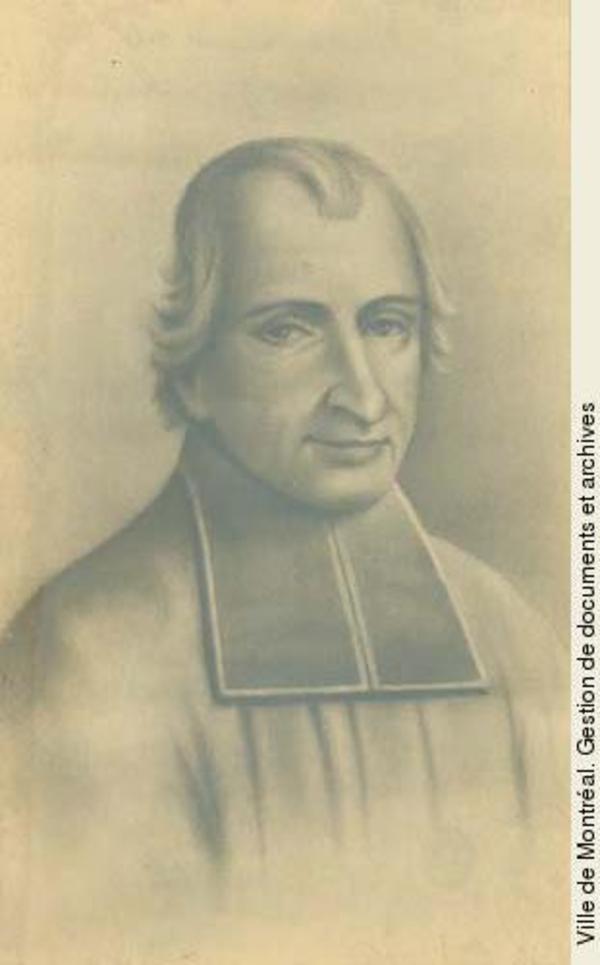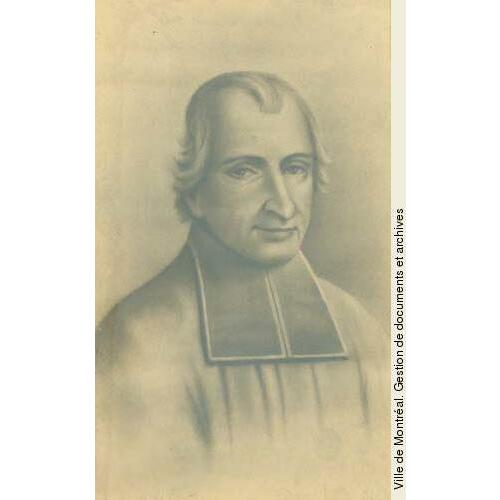
Source: Link
NORMANT DU FARADON, LOUIS, priest, Sulpician, bursar, director, and superior of the Sulpician seminary in Montreal, vicar general; b. 18 May 1681 at Châteaubriant, France, son of Charles Normant, a doctor, and Marie Legrand, Dame Du Faradon; d. 18 June 1759 in Montreal.
After completing his secondary education in Nantes, France, Louis Normant Du Faradon studied theology at the Sulpician seminary in Angers and was admitted into the Society of Saint-Sulpice in Paris on 2 Nov. 1706. At first he was entrusted with various important posts in the administration of the order, including the office of bursar of the seminary of Paris. In 1722 Normant insisted on going to Canada, and the superior general, François Lechassier, consented all the more willingly because François Vachon* de Belmont, the superior in Montreal, was elderly and Normant possessed the qualities required to assist him. Consequently, shortly after his arrival in Montreal, he was appointed bursar and director (vice-superior) of the Society of Saint-Sulpice in Canada.
The new bursar’s early years in Montreal were distinguished by two events. On 25 Feb. 1725, provided with a procuration from the Sulpician seminary in Paris, the seigneur and owner of Montreal Island and Saint-Sulpice, Normant Du Faradon took the oath of fealty and homage to the governor general, Philippe de Rigaud* de Vaudreuil, in Quebec. Later, on 1 Sept. 1731, he appeared before the intendant, Hocquart*, to present the recognition of sovereignty and census for these two seigneuries, an important document for the history of Montreal Island.
Upon Vachon de Belmont’s death on 22 May 1732, Normant Du Faradon became superior of the seminary of Montreal. Shortly afterwards he had to take up the difficult problem of the efficient operation and upkeep of the Hôpital Général of Montreal, founded in 1692 by the Brothers Hospitallers of the Cross and of St Joseph [see François Charon* de La Barre]. Around 1735 this community, with serious financial difficulties and short of personnel, was in danger of disappearing. In 1747 the Charon Brothers ran out of money and gave their resignation [see Jean Jeantot]. The superior of the Sulpicians had long foreseen this outcome and in anticipation had already prepared successors for the Charon Brothers. He suggested to the authorities of the colony that they be replaced by the Grey Nuns.
M. Normant had taken an active part in the founding of this new institution by Marie-Marguerite d’Youville, née Dufrost* de Lajemmerais, in 1738. He had encouraged the foundress to devote herself to the service of the poor and the ill. After the sisters had settled into a house near the church of Notre-Dame with a few poor persons, he visited them frequently, encouraged them to persevere, even drew up for them a set of rules which form the basis of the constitutions of the Grey Nuns. The superior believed that the new community offered sufficient guarantees to enable it to take over management of the Hôpital Général. But Governor Charles de Beauharnois, Bishop Pontbriand [Dubreil], and Intendant Hocquart* were less convinced. At first they opposed the superior’s project, but subsequently they were obliged by circumstances to agree in 1747 to entrust the management of the hospital temporarily to Mme d’Youville and her nuns.
The experiment was, however, short-lived, for in 1750 Intendant Bigot*, with Bishop Pontbriand and Governor La Jonquière [Taffanel], issued an ordinance suppressing the institution and transferring all its belongings to the nuns of the Hôpital Général of Quebec. The Sulpician then began to intervene more frequently and more insistently. Foreseeing even before the ordinance appeared a disadvantageous resolution, Normant Du Faradon had drawn up a petition, signed by the Grey Nuns, in which he pointed out to the authorities the considerable harm that the suppression of the Hôpital Général would cause the inhabitants of Montreal. After Bigot’s ordinance, Normant, in view of the citizens’ increasing discontent, took the initiative of sending in their name a supplication to Rouillé, the minister of Marine. At the same time he made the whole affair known to the superior general of the Society of Saint-Sulpice, Jean Couturier, who had great influence at the court of France. Thanks to these several measures Normant finally obtained the most favourable solution that could be hoped for. In 1753 Louis XV put Mme d’Youville by letters patent back in possession of the Hôpital Général and gave final approval to the community that she had founded.
Normant Du Faradon’s activity was not limited to the town of Montreal. As representative of the superior general in Paris, he was responsible for the administration of all domains owned by the seminary of Saint-Sulpice in Canada, which included three seigneuries: Montreal Island, Saint-Sulpice, and Lac-des-Deux-Montagnes. In 1735 the Sulpicians obtained at M. Normant’s request an increase in the last-named seigneury by more than half, so that the Indians at Lac-des-Deux-Montagnes would have a larger hunting region. In that same year the Sulpicians increased their domain by accepting half of the fiefs of Saint-Herman and Bourgchemin, which Bishop Dosquet*, a former Sulpician, had given them before his final departure for France. These fiefs were located south of the seigneury of Sorel, on both sides of the Rivière Yamaska. The wars at the end of the French régime prevented settlers from being established on these lands and those at Lac-des-Deux-Montagnes, but Normant Du Faradon did succeed in developing almost the whole of the seigneuries of Saint-Sulpice and Montreal Island.
In 1726 Bishop Saint-Vallier [La Croix*] had appointed Normant Du Faradon vicar general for the region of Montreal; Bishop Dosquet had confirmed him in this office in 1729 and named him administrator of the diocese of Quebec during his long absences, from 1732 to 1733 and from 1735 to 1739. During the second period the Sulpician carried out certain functions that normally rested with the bishop. Thus in 1738 and 1739 he made canonical visits in the parishes of Saint-Pierre-de-Sorel and La Visitation-de-l’île-Dupas, in Saint-Charles-de-Lachenaie, where he arranged a rebuilding of the presbytery, in Sainte-Trinité-de-Contrecœur and in Saint-Joseph-de-Chambly, where he ordered that the churches be rebuilt, and in Pointe-Olivier (Saint-Mathias), where he had a chapel built.
On 20 Aug. 1740, the day of Bishop Pourroy* de Lauberivière’s death, the chapter of Quebec took upon itself not to renew Normant Du Faradon’s appointment as vicar general. But a year later Bishop Pontbriand re-established him in his functions, which he exercised until 1759. During this second term of office Normant Du Faradon gave his attention especially to building churches. The religious edifices in the Montreal region needed to be renovated as a result of the increase in population and the progress in colonization over 30 years. The number of settlers and the area of cleared land had more than doubled. Old buildings that had become inadequate had to be enlarged or demolished and replaced with larger ones. Moreover, the newly cleared lands were generally in the rear of the old seigneuries, far from the churches, which were usually at the opposite end, on the waterways; the churches had become virtually inaccessible to the settlers, who asked that new parishes be created. Bishop Pontbriand noted this problem at the time of his first pastoral visit in 1742, and he issued several ordinances calling upon the parishioners to renovate or enlarge their churches. Afterwards it was the vicar general’s job to carry out the ordinances, if necessary choose the sites of the new buildings, approve the architects’ plans, find means of providing for the upkeep of the parish priests, and dedicate the new places of worship.
This was no new task for the Sulpician. In the period 1729–40 he had superintended the building of several churches: Notre-Dame-de-Lorette at Lac des Deux-Montagnes, Saint-Louis-de-Terrebonne at Saint-Laurent, Montreal Island, Saint-Denis (Saint-Denis-sur-Richelieu), Saint-Joseph-de-Chambly, Pointe-Olivier, and the presbytery and chapel of Sainte-Geneviève-de-Pierrefonds. In 1742 the vicar general superintended the building of two churches on Île Jésus: Saint-Vincent-de-Paul and Sainte-Rose. In 1744 the parishes of Saint-Constant and Saint-Philippe were created deep in the seigneury of Laprairie, and Bishop Pontbriand directed the parishioners to obtain the approval of his vicar general for two churches, which were built in 1749 and 1751. Finally, during the pastoral visit of 1749, the bishop ordered four churches to be rebuilt in stone, all of them situated on the domain of the seminary of Saint-Sulpice: Saint-Joachim-de-la-Pointe-Claire, La Visitation du Sault-au-Récollet, Saint-Pierre-du-Portage-de-L’Assomption, and Sainte-Geneviève-de-Pierrefonds. These many and varied works, carried out under the ultimate direction of Louis Normant Du Faradon, suffice to justify his title of church-builder.
In 1753 the superior was stricken with a serious illness from which he never recovered fully and which forced him to give up some of his occupations. To help him he called upon Étienne Montgolfier*, whom he had already begun to initiate into the affairs of the seigneuries, and on 21 Jan. 1759, some months before his death on 18 June, he entrusted all the administration to him, resigning in his favour.
With Louis Normant Du Faradon the seminary of Montreal lost one of its most remarkable superiors. A man of learning and virtue, endowed with sound judgement, he distinguished himself above all by the extent of his knowledge of civil and ecclesiastical law, which enabled him to direct the temporal affairs of Saint-Sulpice most efficiently.
AD, Loire-Atlantique (Nantes), État civil, Châteaubriant, 20 mai 1681. ASSM, Catalogue historique et chronologique des prêtres du séminaire de Montréal; Section des biographies; Section des concessions de terre et d’emplacement de l’île de Montréal; Section des titres de propriété du séminaire de Montréal. “Aveu et dénombrement pour l’île de Montréal,” APQ Rapport, 1941–42, 3–163. Allaire, Dictionnaire. Le diocèse de Montréal à la fin du dix-neuvième siècle (Montréal, 1900). Gauthier, Sulpitiana. P.-G. Roy, Inv. concessions. É.-J. Auclair, Sainte-Rose-de-Laval; notice historique sur les origines de la paroisse (Montréal, 1940). C.-P. Beaubien, Le Sault-au-Récollet; ses rapports avec les premiers temps de la colonie; mission-paroisse (Montréal, 1898). A.-L. Bertrand, Bibliothèque sulpicienne, ou histoire de la Compagnie de Saint-Sulpice (3v., Paris, 1900). Azarie Couillard-Després, Histoire de la seigneurie de Saint-Ours (2v., Montréal, 1915); Histoire de Sorel de ses origines à nos jours (Montréal, 1926). J.-U.-A. Demers, Histoire de Sainte-Rose, 1740–1947 (Montréal, 1947). René Desrochers, “Précis historique, deuxième centenaire de la paroisse Saint-Mathias,” Souvenir des fêtes du deuxième centenaire de la paroisse Saint-Mathias (Montréal, 1939). [É.-M. Faillon], Vie de Mme d’Youville, fondatrice des Sœurs de la Charité de Villemarie dans l’île de Montréal, en Canada (Villemarie [Montréal], 1852). Gosselin, L’Église du Canada jusqu’à la conquête. Lemire-Marsolais et Lambert, Histoire de la Congrégation de Notre-Dame, III, IV, V. L.-P. Phaneuf, Historique de Saint-Mathias (Cahiers de la Société historique de la Vallée du Richelieu, V, Saint-Jean, Qué., 1955). Christian Roy, Histoire de L’Assomption (L’Assomption, Qué., 1967). Robert Rumilly, Histoire de Saint-Laurent (Montréal, 1969). Émile Salone, La colonisation de la Nouvelle-France; étude sur les origines de la nation canadienne française (Paris, 1906; réimp. Trois-Rivières, Qué., 1970). Trudel, L’Église canadienne. Jacques Viger, Archéologie religieuse du diocèse de Montréal, 1850 (Montréal, 1850). J.-J. Lefebvre, “Saint-Constant et Saint-Philippe de Laprairie, 1744–1946,” SCHÉC Rapport, 1945–46, 125–58.
Cite This Article
Antonio Dansereau, “NORMANT DU FARADON, LOUIS,” in Dictionary of Canadian Biography, vol. 3, University of Toronto/Université Laval, 2003–, accessed January 1, 2026, https://www.biographi.ca/en/bio/normant_du_faradon_louis_3E.html.
The citation above shows the format for footnotes and endnotes according to the Chicago manual of style (16th edition). Information to be used in other citation formats:
| Permalink: | https://www.biographi.ca/en/bio/normant_du_faradon_louis_3E.html |
| Author of Article: | Antonio Dansereau |
| Title of Article: | NORMANT DU FARADON, LOUIS |
| Publication Name: | Dictionary of Canadian Biography, vol. 3 |
| Publisher: | University of Toronto/Université Laval |
| Year of publication: | 1974 |
| Year of revision: | 1974 |
| Access Date: | January 1, 2026 |



